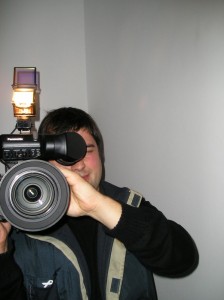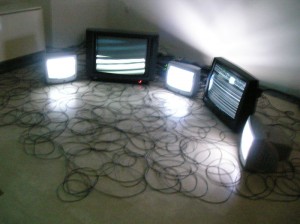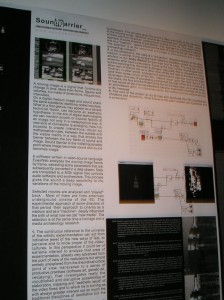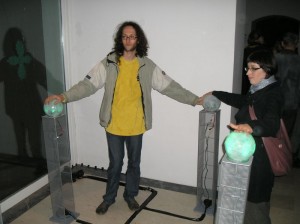I spent the first couple nights in Ljubljana at the “#1 hippest hostel in the world” as determined by Lonely Planet. Since I’ve been stubbornly avoiding carrying any tourist guidebooks on this trip, I was unaware of this when I checked in. I just picked the closest hostel to the train station marked on the map I got from the tourist office. The place actually was pretty cool. It’s located inside a renovated military prison; local artists decorated many of the rooms, and there’s a small art gallery on the ground floor. They offered a daily tour, which I never got around to taking. I imagine in high-season it would be quite the place the be, but in November it was mostly empty. However, the lack of guests didn’t cause them to lower their prices, or stop them nickle-and-diming you with €4/hour internet access and overpriced drinks at the bar. These are the things you can do when you’re the hippest hostel on the face of the Earth, I suppose.
I did meet another guest, an American from Hollywood. He works for Jerry Bruckheimer’s production company, scouting new scripts, or books that can be made into scripts and then finding “punch-up” writers to improve the scripts or rework the books into scripts. Shockingly, despite this description he was not at all intolerable! Going to school in LA for 4 years, I’ve run into my share of “Hollywood people” before, and usually despise them within minutes. This guy seemed genuinely open, curious and friendly; he wasn’t arrogant or trying to impress me, and didn’t even tell me what he did until I asked. We went to the Slovenian National Gallery together (it’s free on Sundays) and he seemed genuinely interested in my (admittedly minimal) knowledge of different art styles, and the classical mythology / Christian iconography depicted therein.
Monday, I went to the opening event of the Hack, Act, Interact, Progress (HAIP) festival at an art gallery. It was very busy, with a variety of international artists and interested onlookers. There was free wine and little cracker/bread snacks. The local media was also out in force with photographers and television cameramen wandering around. The TV cameras were particularly intrusive. I was pleased that the media thought a tech-art event was worth covering, but I got kind of sick of the camera guy with a bright light following me around, apparently trying to get footage of somebody “experiencing” the art or something. Every time I turned to look at him, he gestured at me to keep looking at whatever I was looking at before. Finally, I pulled out my own camera and snapped a photo of him.
I’m not much of an art critic, so I don’t really feel at all qualified to judge the artistic merit of the exhibits at the gallery. For anyone interested, there are much better explanations of the different exhibits available on the HAIP website. Several of them were sort of glitch/feedback-based, taking initial input from an Andy Warhol film, a video camera trained on a screen showing the output of the camera, or a “silent” 1920s recording by the futurist Luigi Russolo, and then processing the input with various digital or analog mechanisms before outputting it to screens or speakers. The results were interesting-looking, and usually obnoxious-sounding.
Another project by a Polish artist involved stealing a video surveillance camera and setting it up in a train station, projecting the camera’s video, and motion-tracking software output on the wall for passers-by to see. I though this was an effective, if very blunt way to draw attention to the ubiquity of surveillance present in modern society.
Another piece had several pillars topped with little globes. The globes would light up, flicker and make noise in response to being touched by audience members. It was kind of fun, but I had a tough time figuring out exactly what the underlying idea was, or how exactly the globes’ response was keyed to the input.
There was also a video showing two previous projects involving “neurofeedback technology”. Basically, a participant wears a low-resolution EEG headset that monitors activity in the premotor cortex. By imagining moving certain body parts, the left hand, for example, the subject can pass commands to the computer. In one project, the input was linked to Google maps; in the other, they used thought-commands to compose an audiovisual performance.
As a neuroscience major, I find the idea of controlling a computer with thoughts alone undeniably cool. It also has potentially very important applications for paralyzed people. Sadly, they didn’t have the actual EEG setup at HAIP to play with, just a video of people using it. I did get the chance to try this system personally at Wired NextFest last year in Los Angeles, and I can tell you there’s a long way to go before thought-input is anywhere near as convenient as a mouse and keyboard. It takes a fair amount of focus and concentration to generate the necessary brain activity. Further, EEGs are a very noisy input source. It’s basically just a bunch of electrodes on the outside of your head, so all sorts of minor movement of your eyes, eyebrows, forehead generates electrical activity that interferes with the signals from your brain. As a result, the system has to be sort of dull and unresponsive in order to avoid mis-cues. You have to think pretty hard about moving your left hand for a pretty sustained period of time (5-15 seconds) before you can make a left-click, for example.
Another project I thought was really cool in theory, but somewhat underwhelming in practice. Titled The Black Box Sessions, the idea was to have a special, improvised performance for an audience of one. I entered a completely dark room alone, and peered into a peephole on one wall. Inside was a display of a night-vision camera trained on me. It was kind of a cool shift in perspective to watch myself watching myself, but that was all I saw. Talking to the artist later, there were supposed to be computer-generated images added to the camera view and improvised music performed by musicians in another room. There was a lot of ambient noise from the crowd talking in the next room that might’ve drowned out the music, and it’s possible I didn’t wait long enough for the visual part of the performance to happen.
I also met a woman named Katja who’s the PR director for Kiberpipa, the main organizer of the festival. She was very friendly and welcoming, and actually invited me to give a talk later in the week.





No Comments so far ↓
There are no comments yet...Kick things off by filling out the form below.